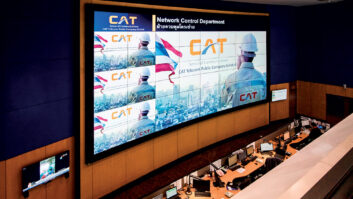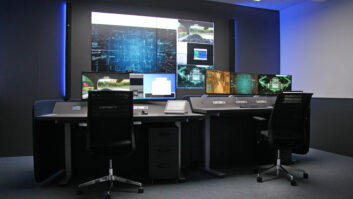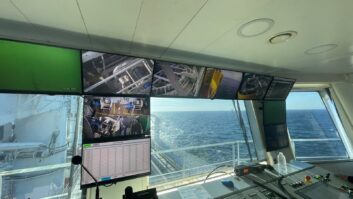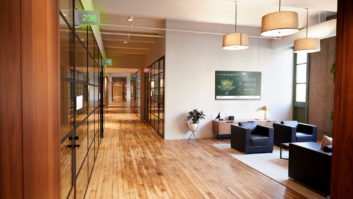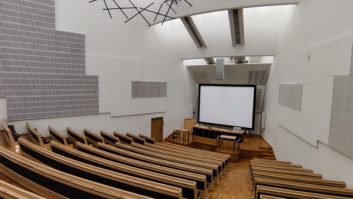The frequency with which control rooms have put cutting edge technologies to the test – from UHD resolution video to complex IP infrastructures – has been repeatedly reinforced in Installation over the years. This latest overview is no exception, but what makes it more exceptional this time around is that it comes after a period of sustained challenges – not necessarily to do with demand, which has remained strong, but around persistent supply chain problems that transcend industries.
Joe da Silva, vice president of marketing for Extron, remarks: “From our perspective, the demand for these spaces has remained strong, and in some markets such as healthcare and government services it has increased. What has been impacted is a manufacturer’s ability to deliver the products to meet demand. Extron’s command and control room offerings have continued to be accessible, despite the turbulence of the past few years.”
Jochen Bauer, director of sales at Guntermann & Drunck (G&D), adds: “The pandemic and the supply chain have caused some problems concerning the procurement of complementary products. This led to some delays and there is currently a catch-up effect we are dealing with. Still, we are optimistic about the future and are receiving inquiries for major projects.”
The general tone here of ‘optimism despite challenges’ is indicative of a market that appears to be thrumming with activity as we enter the second half of 2023. Contributors to this article variously alluded to projects in the energy industry, maritime and air traffic control, industrial facilities, broadcast centres and other ‘mission-critical’ environments. Technology-wise, IP continues to be a driving force behind many new projects, while the latest visual display technologies are also doing well in this space. Inevitably in a world where cybercrime is continuing to increase, security is another top priority.
TECH FUNDAMENTALS
Some technological fundamentals remain unaltered, and in the control room environment none are more integral than KVM (keyboard, video, mouse) solutions that can be employed to connect multiple users to many different computers. With the possibility of connecting users in multiple locations, potentially around the world, KVM solutions are often designed to support effective real-time control and collaboration. While there continues to be a demand for point-to-point KVM products that extend keyboard and mouse functionality, recent years have seen a sharp increase in demand for KVM-over-IP that delivers network availability of multiple computer sources. (See page 32 for a more in-depth look at KVM.)
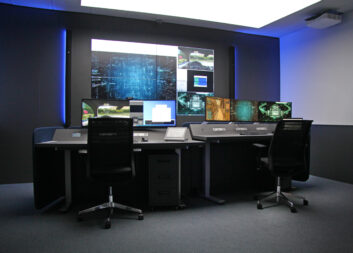 “KVM systems are often the backbone of the infrastructures,” says Bauer, who alludes to an ongoing focus at G&D on solutions for implementing redundancy. “New to the portfolio is an additional feature for securing an overall installation in KVM-over-IP environments called DirectRedundancyShield, which guarantees a fully redundant and failsafe infrastructure.”
“KVM systems are often the backbone of the infrastructures,” says Bauer, who alludes to an ongoing focus at G&D on solutions for implementing redundancy. “New to the portfolio is an additional feature for securing an overall installation in KVM-over-IP environments called DirectRedundancyShield, which guarantees a fully redundant and failsafe infrastructure.”
The principles of KVM also resonate with an increased industry-wide emphasis on energy reduction. Bauer notes: “KVM ensures that control rooms can be operated more energy efficiently. By outsourcing technology from workspaces, KVM not only improves noise in the working environment of control rooms, but also reduces the development of heat. With our PersonalWorkplace-Controller, multiple sources can be arranged on just one monitor. [In addition] G&D products are extremely durable with a long product lifecycle.”
For Extron, da Silva indicates that supporting technologies and requirements have changed while “conceptually, the purpose of these rooms has remained the same.” The company has offered “traditional USB extension, and keyboard and mouse switching for many years; we then added that functionality to our fibre matrix switchers and endpoints. Our current FOX3 [fibre optic distribution solution] with the optional LinkLicense for KVM System Configuration and Control enables a user at a workstation to control up to four remote computers with a single keyboard and mouse. A key development is the SmartGlide KVM Switching feature that provides automatic, fast and seamless keyboard and mouse switching as the mouse glides from one workstation display to the next.”
InfoComm 2023 saw Ross Video launch its first KVM matrix solution, Connexus, which is described as providing a ‘true’ hybrid 2K/4K KVM endpoint and an intuitive enterprise-level KVM management system. Most synonymous with the broadcast world – where its production switchers, video servers and replay systems are commonly found – the company has long had a presence in the control room space, but acknowledges that there is now a burgeoning convergence between broadcast- and AV-style applications.
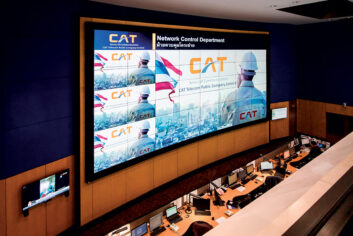 Ahead of the recent show, Ross Video senior vice president vertical markets and solutions, Jared Schatz, said that its involvement in the Orlando gathering underlined its “growing focus on the AV industry. Our aim is to blur the lines from broadcast to AV, making the technology more accessible for a variety of industries. We are empowering our clients to navigate complex broadcast solutions more efficiently”.
Ahead of the recent show, Ross Video senior vice president vertical markets and solutions, Jared Schatz, said that its involvement in the Orlando gathering underlined its “growing focus on the AV industry. Our aim is to blur the lines from broadcast to AV, making the technology more accessible for a variety of industries. We are empowering our clients to navigate complex broadcast solutions more efficiently”.
To this end, InfoComm (see page 38 for our show report) also saw Ross showcase its new Quorum meeting control solution – designed to provide government, legislators and corporations with ‘broadcast-quality’ production, automated multi-camera tracking, professional-looking graphics and intuitive touch controls – and D3 LED display solutions that offer advanced features such as colour calibration, image processing and remote management.
Lightware Visual Engineering is another company to be tackling broadcast-AV convergence, including in more broadcast-oriented environments. CEO Gergely Vida remarks: “Control rooms are the nerve centre of broadcast and media operations, encompassing television studios, radio stations and live event production. Offering advanced pro AV room equipment, including matrix switchers, [has brought] success in this sector for us. The increasing demand for high-quality content production and live streaming has further driven the growth of this market segment. We are proud that the solutions and devices of Lightware contributed to the success of the Eurovision Song Contest 2017, the Olympic Games, and the Expo 2020 in Dubai – just to mention a few world-class broadcast events.”
BLENDED CONTROL
The blending of increasingly powerful control systems with evolving display technologies is a recurring theme for vendors in this space, and VuWall is no exception. CEO & founder Paul Vander Plaetse recalls: “The control room market is rapidly evolving, where operators are dealing with fast-paced changes due to volatile macroeconomic and geo-political factors. In recent years, we have observed a growing need for operators to have more autonomy in how they use their control rooms. Previously, system integrators configured the different work presets based on their pre-established processes.
“Today, they must adjust their work scenarios and processes so often that they demand systems that they can configure themselves, at a moment’s notice, without any programming. VuWall’s solution designs and development prioritise the ability to quickly and easily operate and reconfigure presets. [In addition] as display technology has become more affordable resulting in a significant increase in the number of control rooms being built, especially small to medium size control rooms, VuWall solutions are designed to be scalable in order to accommodate control rooms of any size.”
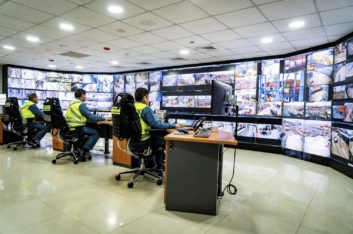 Having initially focused on the development of video wall control solutions, VuWall now offers a complete ecosystem of products for multi-video wall control and AV over IP distribution, including the TRx centralised control software.
Having initially focused on the development of video wall control solutions, VuWall now offers a complete ecosystem of products for multi-video wall control and AV over IP distribution, including the TRx centralised control software.
“From a central TRx server, our customers can manage the content on multiple video walls and easily route any signal from one location to another with easy drag-and-drop operations,” says Plaetse. “This year, we have added IP KVM functionality to our software, allowing operators to control remote sources from their workstations, and even interact, share and control those sources on the main video wall or with other operators via their keyboard and mouse. For the remainder of 2023, we will continue to develop solutions that simplify the user experience with even more advanced touch panel control. The objective is to increase operator efficiency and improve response times.”
SECURITY THREATS
Several of the recent technology trends – especially those supporting remote control and connectivity – undoubtedly make remote working more straightforward. But with security often being an overriding priority, opinion is somewhat divided as to how much remote working is now ongoing in control room environments.
“The Covid-19 pandemic has accelerated the adoption of virtual room solutions,” says Vida. “With the need for remote operations and collaboration, companies have sought innovative approaches to maintain room functionalities while ensuring the safety and well-being of their personnel. This shift towards remote room setups has altered the market dynamics and opened up new avenues for companies to provide flexible and scalable solutions.”
Schatz adds: “Remote production and work from home solutions are still top of mind. Many customers that resisted remote workflows have now embraced them, but the current preference is still in person, [although] our customers want to make sure they have the option to do remote production as well. I foresee this trend continuing throughout the next few years.”
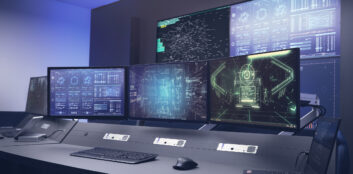 Toine C. Leerentveld, director product management, cloud & controls at Crestron, comments: “The real changes have to do with virtualising the traditional command and control (C&C) centre, enabling easy access, collaboration, and sharing of relevant data and ensuring real-time communication. Control centres are smaller, and often they are replicated in various spaces around the world. We see traditional meeting rooms increasingly being used as ad-hoc C&C centres.”
Toine C. Leerentveld, director product management, cloud & controls at Crestron, comments: “The real changes have to do with virtualising the traditional command and control (C&C) centre, enabling easy access, collaboration, and sharing of relevant data and ensuring real-time communication. Control centres are smaller, and often they are replicated in various spaces around the world. We see traditional meeting rooms increasingly being used as ad-hoc C&C centres.”
Plaetse echoes the sentiments about the rise in remote working, but indicates that on-site operations have returned as pandemic conditions have receded: “Recent challenges have taught everyone, including control room operators, to work remotely. This accelerated a process that was slowly evolving already with technology that allowed teams to collaborate from multiple locations. Although control rooms have been resistant to remote operations for security reasons, organisations have developed methods and technology to secure the process. However, most control rooms reverted to onsite operations in 2023, with the technology in place to go remote if necessary.”
CONTROL RETURN
In a worsening cybersecurity environment – not least with companies in sectors such as broadcast/media and energy being specifically targeted – it’s perhaps not surprising that many organisations are specifying an en masse return to the control room. Nonetheless, there is a demand for vendor solutions to be protecting against multiple cyber threats, including via compliance with specific technical standards.
Leerentveld comments: “Of utmost importance for the control room market is complying with IT Security standards (NIAP/JITC), something Crestron puts at the forefront of our technology. [For instance] the move to software-based control systems with redundancy and fault-tolerance — which are 100% controlled by an organisation’s IT department — makes systems easier to scale, and hardens the solutions to reduce the attack vectors on our systems.”
Brandon Rhoda, applications manager – vertical markets & solutions at Ross Video, adds:: “When it comes to security we have had active efforts for some time now to ensure our clients are purchasing products that are secure. One of the ways we are leading the effort is through an initiative called Catena. Catena is an open, multi-vendor standard, led by Ross, to ensure a common standard for control and configuration both on-premise and in the cloud. The need to secure environments and the connections between products and services is a number one priority in the Catena initiative.”
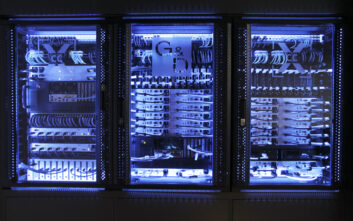 Meanwhile, in the ultimate example of cyber threats being prioritised, Plaetse confirms that they are also leading to the development of new control rooms in their own right: “Today, we are seeing an increased demand in cybersecurity operation centres. Again, the affordability of display technology has resulted in many new applications where investing in a video wall is justified by a quick ROI thanks to gain in productivity.”
Meanwhile, in the ultimate example of cyber threats being prioritised, Plaetse confirms that they are also leading to the development of new control rooms in their own right: “Today, we are seeing an increased demand in cybersecurity operation centres. Again, the affordability of display technology has resulted in many new applications where investing in a video wall is justified by a quick ROI thanks to gain in productivity.”
In terms of other growth applications for control room solutions, our interviewees cited an extensive range – running the gamut from traffic management to defence & security.
“Control rooms play a critical role in defence operations across sectors such as government, transportation, critical infrastructure, and commercial facilities,” says Vida. “Specialising in secure video monitoring, control and military systems offering zero-latency have witnessed significant success for us. With the increasing emphasis on safety and threat prevention, this sector has seen continuous growth and demand.”
It is also bleakly indicative of current times – in which extremist attacks on schools and houses of worship, to name just two examples, have become tragically frequent – that there has also been a drive to build more public safety-oriented control rooms. Courtney Mamuscia is marketing director of RGB Spectrum: “There has been a big emphasis in the world at large on control and monitoring centres. The ability to put up different schematics and see what is happening on a site, and around, it has become very important. For example, in the case of a [security threat at a school] our Zio mobile app could be sent to the police officers entering the site so they could have a clear idea of the layout.”
FUTURE TRENDS
Several contributors also alluded to several specific technology developments in terms of their future potential (or not) for control rooms. UHD and HDR are both very big trends in broadcast, but it seems their adoption path could be more protracted in control rooms.
“UHD is a trend, but most of the installations for our customers are in HD with a standard resolution of 1080 pixel,” notes Bauer. “An exception are KVM solutions in air traffic management, where higher resolution is needed for radar surveillance. HDR is so far only a topic for our broadcast customers.”
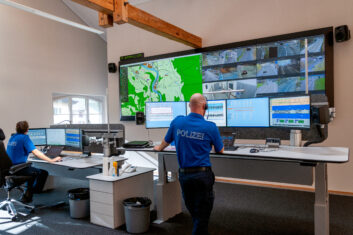 The likelihood of AI and machine learning having a big impact, on the other hand, seems rather more assured. “Looking ahead to the rest of 2023, several trends and launches can be anticipated in the market,” says Vida. “One being the most controversial and popular: AI and machine learning integration. It is on our agenda to focus on leveraging artificial intelligence techniques to enhance control room operations. Others are cloud-based room solutions, enhanced cybersecurity measures, and virtual and augmented reality applications.”
The likelihood of AI and machine learning having a big impact, on the other hand, seems rather more assured. “Looking ahead to the rest of 2023, several trends and launches can be anticipated in the market,” says Vida. “One being the most controversial and popular: AI and machine learning integration. It is on our agenda to focus on leveraging artificial intelligence techniques to enhance control room operations. Others are cloud-based room solutions, enhanced cybersecurity measures, and virtual and augmented reality applications.”
So the long-standing impression that control rooms remains a proving – and critically important first market – for new technologies is firmly underlined by speaking to some of the leading vendors in the space. Impressively resilient to the challenges of the last few years, control rooms will continue to be some of the most fervent ‘early adopters’ of the latest AV solutions.
